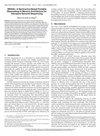MixDiT: Accelerating Image Diffusion Transformer Inference With Mixed-Precision MX Quantization
IF 1.4
3区 计算机科学
Q4 COMPUTER SCIENCE, HARDWARE & ARCHITECTURE
引用次数: 0
Abstract
MixDiT:用混合精度MX量化加速图像扩散变压器推理
扩散转换器(Diffusion Transformer, DiT)在图像生成任务中取得了重大进展。然而,DiT推理是出了名的计算密集型,即使在数据中心规模的gpu上也会导致很长的延迟,这主要是由于它的迭代性质和对基于编码器的结构固有的gem操作的严重依赖。为了应对挑战,之前的工作已经探索了量化,但是实现低精度量化的DiT推理,同时具有高精度和显著的加速仍然是一个悬而未决的问题。为此,本文提出了MixDiT,这是一种算法-硬件协同设计的加速解决方案,它利用混合微缩放(MX)格式来量化DiT激活值。mixditx通过选择性地对基于震级的异常值应用更高精度来量化DiT激活张量,从而产生混合精度的GEMM操作。为了从混合精度算法中获得切实的加速,我们设计了一个MixDiTaccelerator,它可以实现精确灵活的乘法和高效的MX精度转换。我们的实验结果表明,mixdi比RTX 3090提供了2.10 - 5.32倍的加速,而FID没有损失。
本文章由计算机程序翻译,如有差异,请以英文原文为准。
求助全文
约1分钟内获得全文
求助全文
来源期刊

IEEE Computer Architecture Letters
COMPUTER SCIENCE, HARDWARE & ARCHITECTURE-
CiteScore
4.60
自引率
4.30%
发文量
29
期刊介绍:
IEEE Computer Architecture Letters is a rigorously peer-reviewed forum for publishing early, high-impact results in the areas of uni- and multiprocessor computer systems, computer architecture, microarchitecture, workload characterization, performance evaluation and simulation techniques, and power-aware computing. Submissions are welcomed on any topic in computer architecture, especially but not limited to: microprocessor and multiprocessor systems, microarchitecture and ILP processors, workload characterization, performance evaluation and simulation techniques, compiler-hardware and operating system-hardware interactions, interconnect architectures, memory and cache systems, power and thermal issues at the architecture level, I/O architectures and techniques, independent validation of previously published results, analysis of unsuccessful techniques, domain-specific processor architectures (e.g., embedded, graphics, network, etc.), real-time and high-availability architectures, reconfigurable systems.
 求助内容:
求助内容: 应助结果提醒方式:
应助结果提醒方式:


